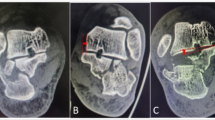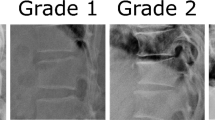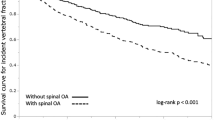Abstract
Study design
Retrospective cohort study.
Objectives
To study the incidence of concomitant calcaneum fractures in participants with traumatic spine fractures and to study the association of calcaneum injury with the mode of trauma, morphology and level of vertebral fracture and neurological status in participants with concomitant spine and calcaneum fracture.
Setting
Central Institute of Orthopaedics, Safdarjung Hospital, New Delhi, India.
Methods
Records of participants with traumatic spine fractures were analyzed. Participants who had calcaneum fracture confirmed on radiographs were considered to have concomitant spine and calcaneum fracture. In these participants, variables noted were age, gender, mode of trauma, level and morphology of vertebral fracture and neurological status.
Results
Concomitant calcaneum fracture was present in 43 participants out of a total of 358. The lumbar spine was involved in 72.09% of participants. 46.51% of participants had complete burst type of vertebral fractures. Neurology was found to be intact in 58.13% of participants. The association of concomitant calcaneum injury with the level of spine fracture and type of fracture were found to be statistically significant (p < 0.05). In particular, the association of concomitant calcaneal fracture with intact neurology and incomplete paraplegia (ASIA B, C or D) as compared to spinal injury cases without calcaneal fractures was statistically significant (p < 0.001).
Conclusion
Calcaneum fractures co-exist with spine fractures in 12.01% participants. Concomitant calcaneal fracture(s) with spine trauma indicate a greater chance of incomplete injury or intact neurology possibly due to dispersion of force vectors.
Similar content being viewed by others
Log in or create a free account to read this content
Gain free access to this article, as well as selected content from this journal and more on nature.com
or
Data archiving
All data generated or analysed during this study are included in this published article [and its Supplementary Information files].
References
Rajasekaran S, Kanna RM, Shetty AP. Management of thoracolumbar spine trauma: an overview. Indian J Orthop. 2015;49:72–82.
Rowe CR, Sakellarides H, Freeman P. Fractures of os calcis: a long-term follow-up study of one hundred forty-six participants. JAMA. 1963;184:920–3.
Mitchel MJ, McKinely JC, Robinson CM. The epidemiology of calcaneal fractures. Foot. 1994;19:197–200.
Walters JL, Gangopadhyay P, Malay DS. Association of calcaneal and spinal fractures. J Foot Ankle Surg. 2014;53:279–81.
Bohl DD, Ondeck NT, Samuel AM, Diaz-Collado PJ, Nelson SJ, Basques BA, et al. Demographics, mechanisms of injury, and concurrent injuries associated with calcaneus fractures: a study of 14,516 participants in the American College of Surgeons National Trauma Data Bank. Foot Ankle Spec. 2017;10:402–10.
Lance E, Wade EC. Factures of the os calcis: a follow-up study. Proceedings of the 22nd Annual Session of the American Association for the Surgery of Trauma, Hot Springs, VA, October 29–31, 1962.
Ertürer E, Tezer M, Oztürk I, Kuzgun U. Evaluation of vertebral fractures and associated injuries in adults. Acta Orthop Traumatol Turc. 2005;39:387–90.
Vaccaro AR, Oner C, Kepler CK, Dvorak M, Schnake K, Bellabarba C, et al. AO Spine thoracolumbar spine injury classification system: fracture description, neurological status, and key modifiers. Spine (Philos Pa 1976). 2013;38:2028–37.
Vaccaro AR, Koerner JD, Radcliff KE, Oner FC, Reinhold M, Schnake KJ, et al. AOSpine subaxial cervical spine injury classification system. Eur Spine J. 2016;25:2173–84.
Vaccaro AR, Lehman RA Jr, Hurlbert RJ, Anderson PA, Harris M, Hedlund R, et al. A new classification of thoracolumbar injuries: the importance of injury morphology, the integrity of the posterior ligamentous complex, and neurologic status. Spine (Philos Pa 1976). 2005;30:2325–33.
Maynard FM Jr, Bracken MB, Creasey G, Ditunno JF Jr, Donovan WH, Ducker TB, et al. International standards for neurological and functional classification of spinal cord injury. American Spinal Injury Association. Spinal Cord. 1997;35:266–74.
Saboe LA, Reid DC, Davis LA, Warren SA, Grace MG. Spine trauma and associated injuries. J Trauma. 1991;31:43–8.
Author information
Authors and Affiliations
Contributions
TB conceptualized the study and was involved in the overall manuscript planning and supervision. AS and RS gave valuable insights. SK was mainly involved in data collection, manuscript writing, submission, and revision as the corresponding author. VC was involved in data collection and manuscript writing. MKP provided valuable interpretations regarding the data analysis and meaning of the results, and participated in responding to reviewers and revising the manuscript. RK was involved in overall supervision of the study, manuscript writing, and provided valuable critical insights. All authors had approved the manuscript.
Corresponding author
Ethics declarations
Competing interests
The authors declare no competing interests.
Additional information
Publisher’s note Springer Nature remains neutral with regard to jurisdictional claims in published maps and institutional affiliations.
Rights and permissions
About this article
Cite this article
Boruah, T., Sareen, A., Sreenivasan, R. et al. Concomitant spine and calcaneum fractures: a possible indication of less extensive injury. Spinal Cord Ser Cases 8, 1 (2022). https://doi.org/10.1038/s41394-021-00473-8
Received:
Revised:
Accepted:
Published:
DOI: https://doi.org/10.1038/s41394-021-00473-8



